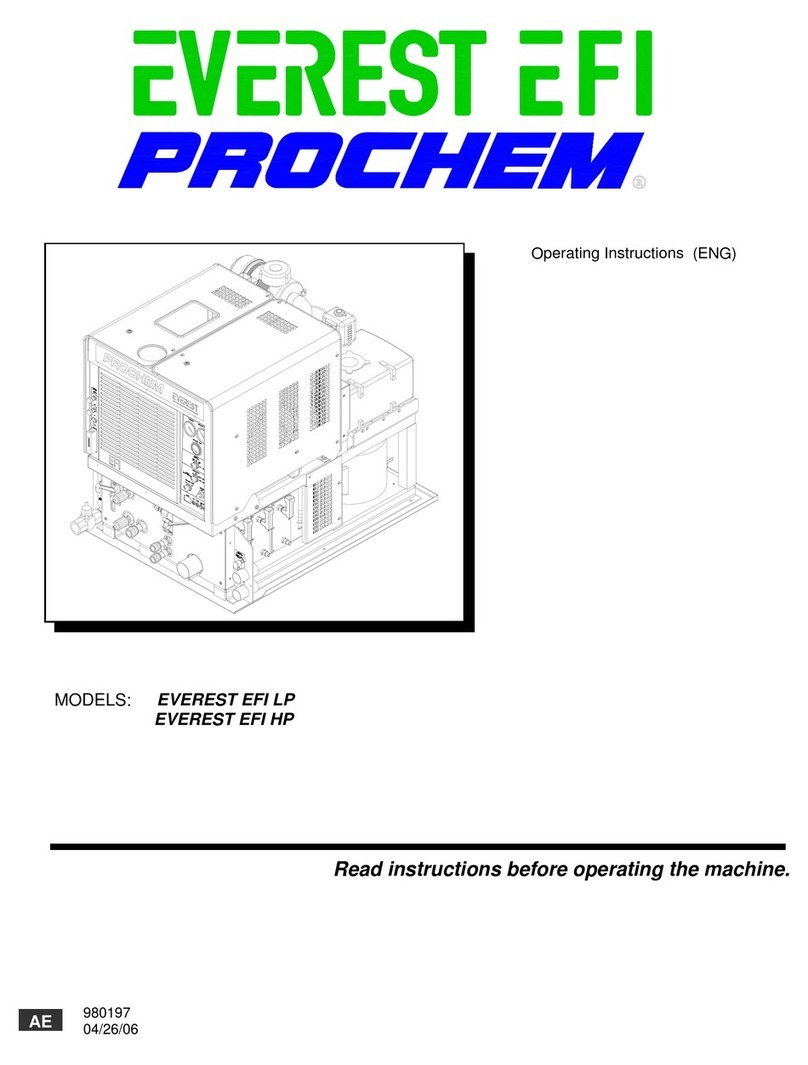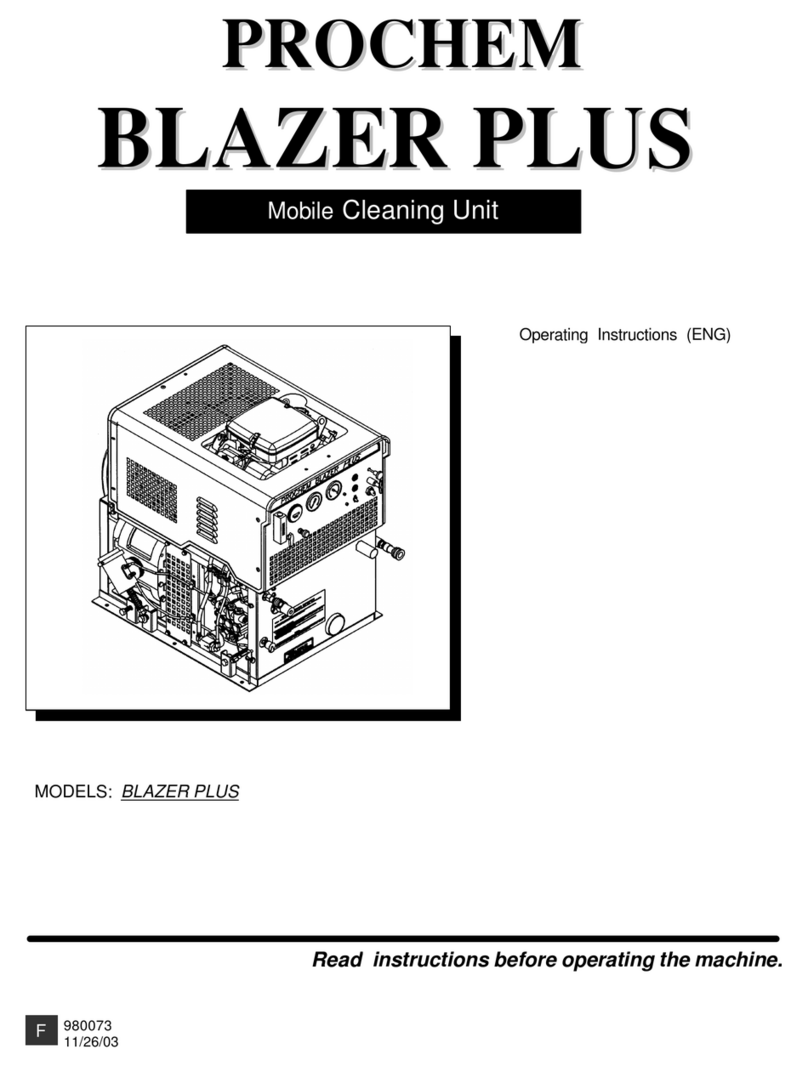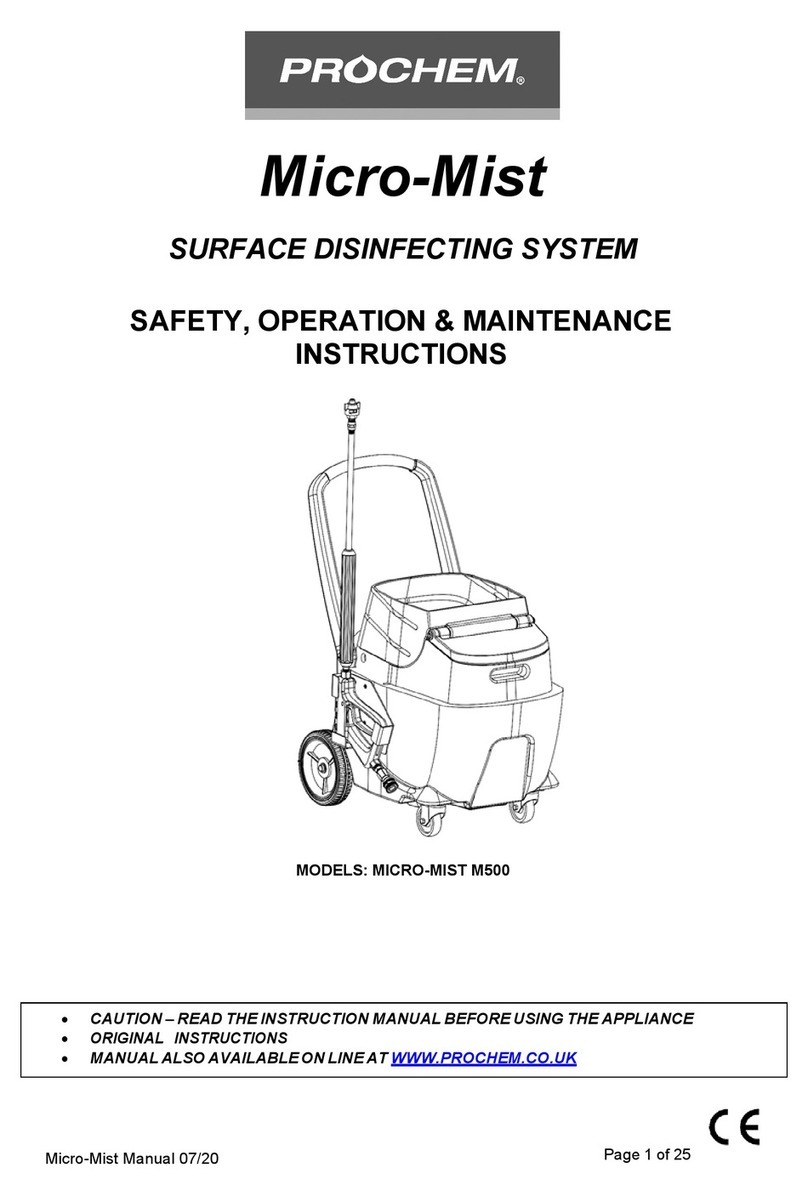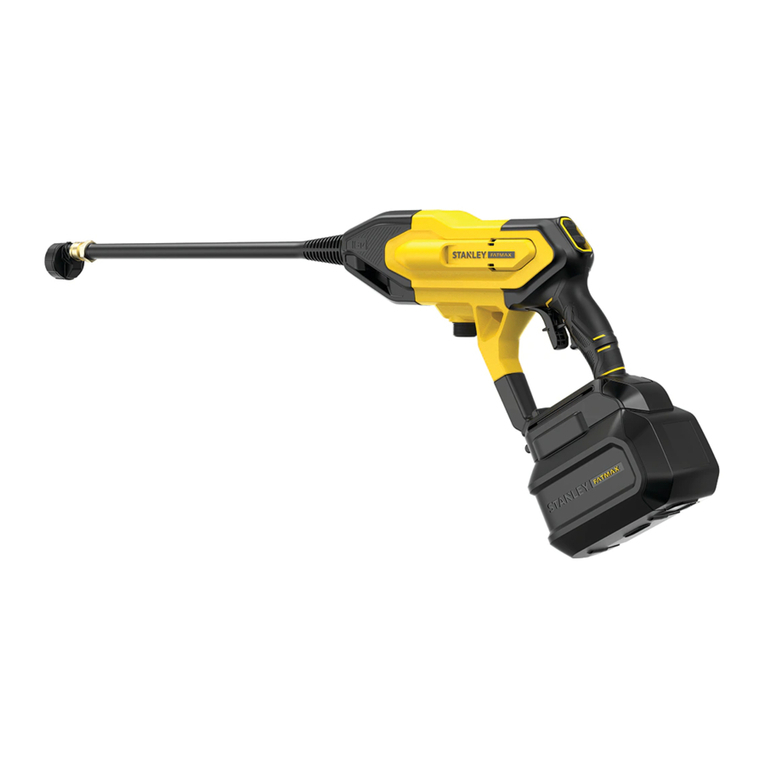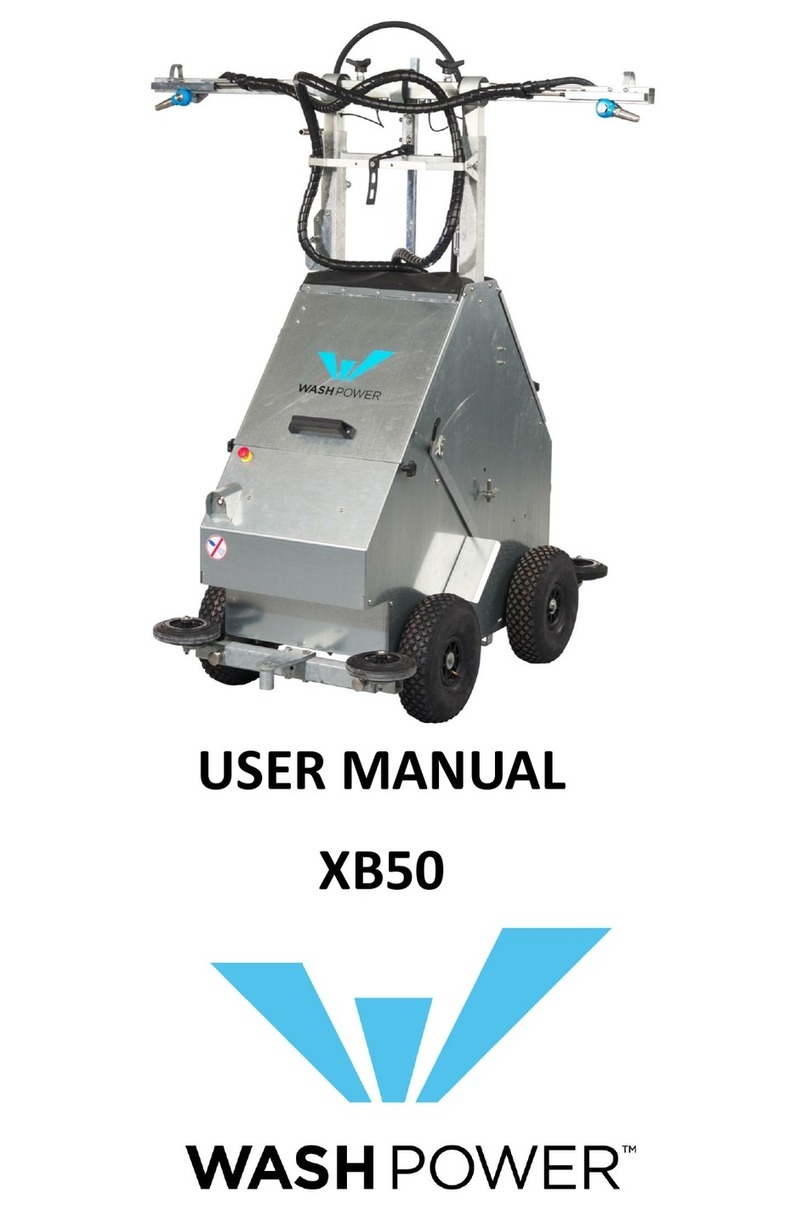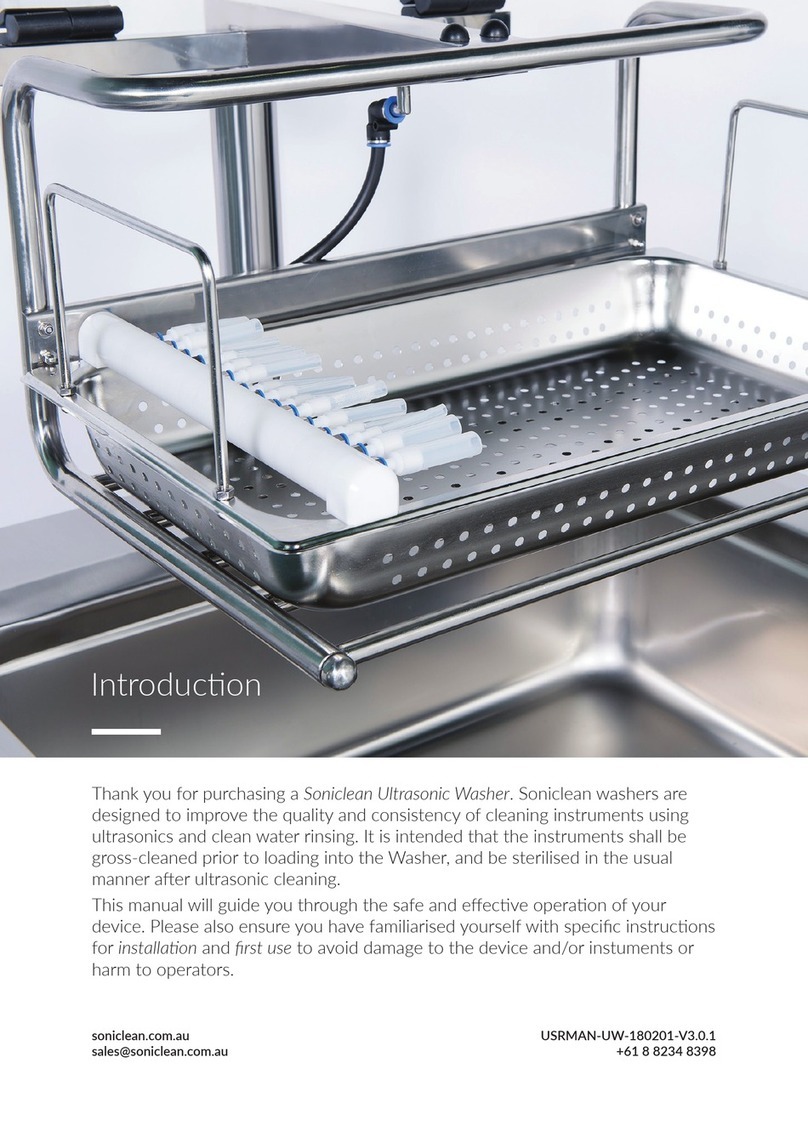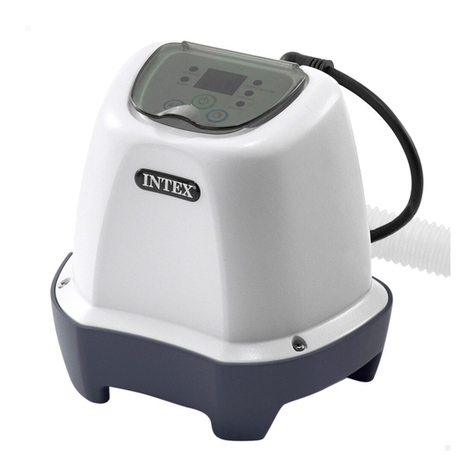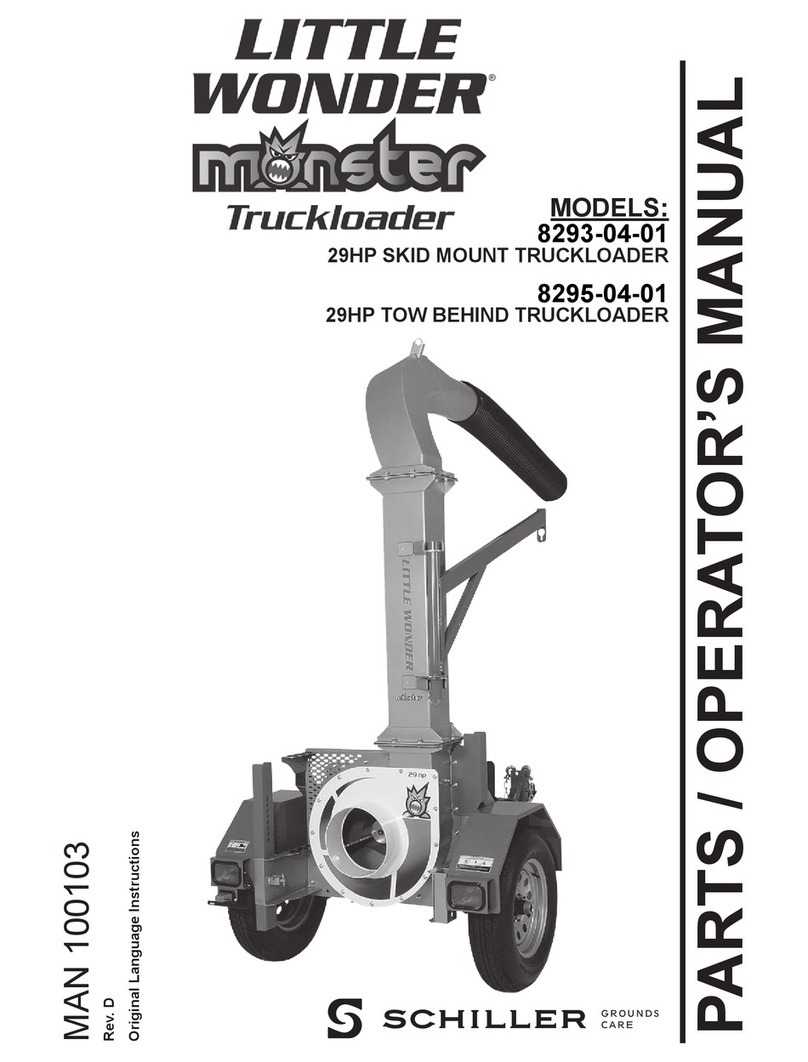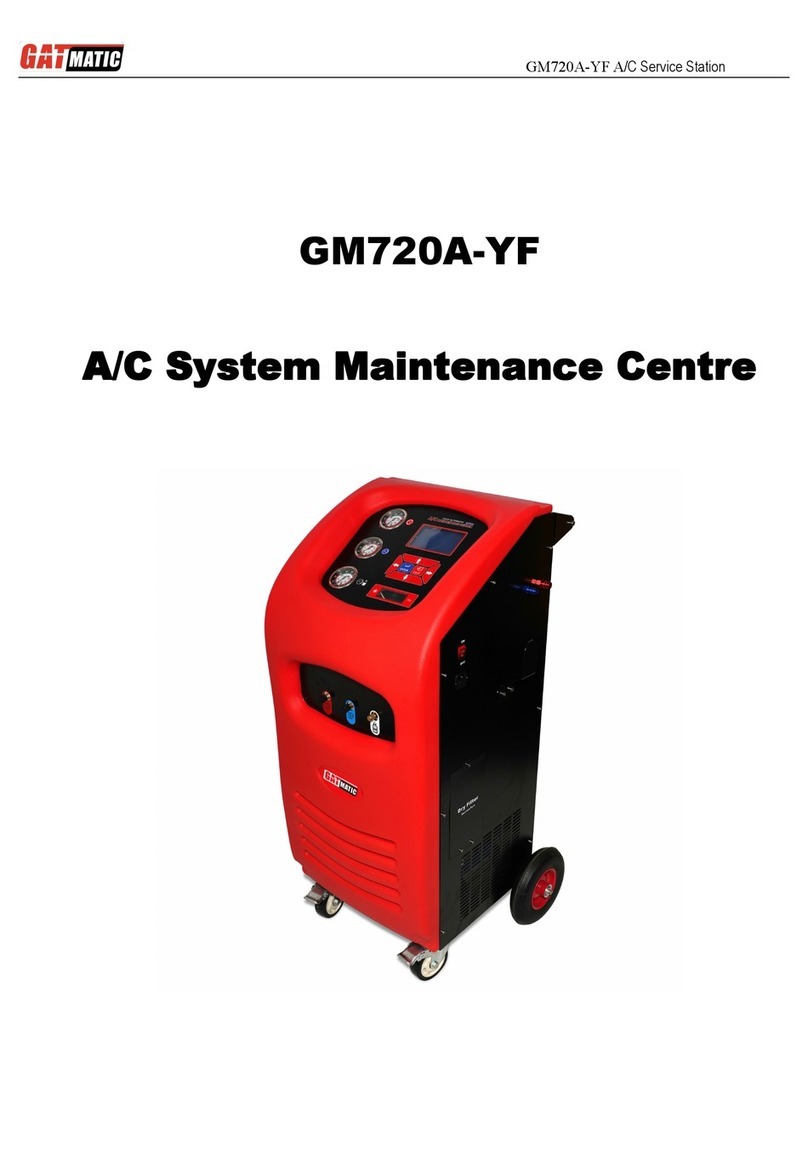Prochem PERFORMER User manual

J
980060
02/10/04
Operating Instructions (ENG)
MODELS: PERFORMER
PERFORMER 405
AUTO HEAT DIVERTER UNITS
Read
instructions before operating the machine.

MACHINE DATA LOG/OVERVIEW
PERFORMER 980060 07/01/02
1
Welcome…and congratulations on your purchase of the PERFORMER/PERFORMER 405 Mobile Cleaning Unit. This
instruction manual is a guide for operating and servicing your PROCHEM unit. Read this manual completely before
installing or operating this unit.
This unit offers you personal convenience. All of your instrumentation and controls have been positioned to give you
easy access for operation and daily maintenance.
Proper operation and service are essential to the efficient functioning of this unit. When maintained correctly, this unit
will have a long, trouble-free life.
The service methods described in this manual are explained in such a manner that servicing may be performed
accurately and safely. Proper service varies with the choice of procedure, the skill of the mechanic, and the tools or
parts available. Before attempting any repair, make certain that you are thoroughly familiar with this equipment and are
equipped with the proper tools. Any questions pertaining to operating or servicing this unit should be directed to your
nearest PROCHEM dealer.
THIS UNIT MUST BE INSTALLED BY THE DEALER FROM WHOM YOU PURCHASED IT IN ACCORDANCE WITH
PRESCRIBED PROCHEM INSTALLATION PROCEDURES.
MAKE CERTAIN THAT THE WARRANTY CARD IS FILLED OUT AT THE TIME OF INSTALLATION AND IS
RETURNED TO PROCHEM!
This operation and service manual is written specifically for the PROCHEM PERFORMER/PERFORMER 405 Mobile
Cleaning Unit which are manufactured by:
PROFESSIONAL CHEMICALS CORPORATION
325 SOUTH PRICE ROAD
CHANDLER, ARIZONA 85224
Information in this document is subject to change without notice and does not represent a commitment on the part of
Professional Chemicals Corporation.
YOUR DEALER
Name: _________________________________________________________________________________________________
Address: _______________________________________________________________________________________________
Phone Number: _________________________________________________________________________________________
MODEL _______________________________________
DATE OF PURCHASE __________________________
SERIAL NUMBER ______________________________
SALES REPRESENTATIVE # _____________________
DEALER NAME ________________________________
OPERATIONS GUIDE NUMBER ___________________
PUBLISHED __________________________________________

TABLE OF CONTENTS
PERFORMER 980060 07/05/03
2
Machine Data Log/Overview..........................1
Table of Contents...........................................2
HOW TO USE THIS MANUAL
How to use this Manual..................................1-1
SAFETY
Safety Instructions.........................................2-1
Hazard Intensity Level...................................2-3
INSTALLATION & OPERATION
Technical Specifications................................3-1
Receiving Your Unit.......................................3-2
Installation Requirements..............................3-3
Fuel.................................................................3-3
Engine Oil.......................................................3-3
Chemicals & Water........................................3-4
Lifting Unit.......................................................3-5
Positioning Unit In Vehicle.............................3-5
Bolting Down Unit And Waste Tank..............3-5
Waste Tank To Console Connection...........3-6
Battery Installation........................................3-6
Fire Extinguisher..........................................3-6
Waste Tank Installation................................3-7
Decal locations.............................................3-8
Water Pumping System..............................3-9
Heat Transfer System.................................3-10
Vacuum System..........................................3-13
Chemical System........................................3-14
Preparation..................................................3-16
Instrumentation...........................................3-17
Starting Unit (Cleaning Mode)....................3-18
Chemical Pump Priming.............................3-19
Waste Pump...............................................3-19
Cleaning......................................................3-20
Upholstery Cleaning....................................3-20
Stair Tool Cleaning......................................3-21
Flood Restoration........................................3-21
Shutdown & Daily Maintenance..................3-21
Freezing Protection.....................................3-22
Removing Anti-Freeze from The Unit.........3-23
MAINTENANCE & SERVICE
Maintenance
Maintenance Schedule............................4-1
Engine......................................................4-2
Vacuum Pump.........................................4-4
Water Pump.............................................4-4
Vacuum Inlet Filter...................................4-4
Drive Belts, Pulleys And Hubs................4-4
Float Valve, Water Pump Inlet Filter.......4-5
Strainer Basket (Waste Tank).................4-6
BypassManifold......................................4-6
Outlet Y-Strainer, Check Valve...............4-6
Chemical Pump, Chemical &
Heat Bypass Valves............................4-6
Nitrogen Accumulator..............................4-6
PressureRegulator..................................4-6
Vacuum Hoses ........................................4-6
Battery.....................................................4-7
Engine Exhaust Heat Exchanger............4-7
Vacuum Exhaust Heat Exchanger..........4-7
High Pressure Hoses..............................4-8
Optional Water Pump..............................4-8
General Service Adjustments
Engine Speed..........................................4-9
Vacuum Relief Valve...............................4-11
Vacuum Pump Drive Belts......................4-11
Water Pump Drive Belt............................4-11
Float Valve...............................................4-11
Bypass Valve...........................................4-12
CheckValve............................................4-12
Chemical Pump.......................................4-12
Packing Nut Adjustment
(Chemical Metering & Selector Valves...4-13
PressureRegulator..................................4-13
Adding/Draining Engine Coolant.............4-13
Temperature Solenoid.............................4-14
Temperature Capillary.............................4-14
Troubleshooting.......................................4-16

TABLE OF CONTENTS
PERFORMER 980060 07/05/03
3
PARTS LIST
Front Panel.....................................................5-1
Framework.....................................................5-3
Engine Assembly, Left...................................5-5
Engine Assembly, Right.................................5-7
Engine Governor............................................5-9
Engine Coolant.............................................5-11
Vacuum Pump- Performer...........................5-13
Vacuum Pump- Performer 405....................5-15
Water Pump.................................................5-17
Water Pump.................................................5-19
Chemical System.........................................5-21
Vacuum Exhaust Heat Exchanger
And Silencer- Performer..............................5-23
Vacuum Exhaust Heat Exchanger
And Silencer- Performer 405.......................5-25
Heli-Coil Heat Exchanger............................5-27
Engine Exhaust Heat Exchanger.................5-29
Solution Outlet..............................................5-31
BypassManifold...........................................5-33
Water Box ...................................................5-35
Pressure Regulator Manifold.......................5-37
Temperature Solenoid
& Bypass Valve ...........................................5-39
Catalytic Air Pump.......................................5-41
Automatic Exhaust Diverter.........................5-43
Waste Tank-Performer................................5-45
Waste Tank-Performer 405.........................5-47
Waste Tank-Performer
100 Gallon (Optional) ..................................5-49
Waste Tank-Performer 405
100 Gallon (Optional)...................................5-51
Automatic Pumpout......................................5-53
Hose Accessories ........................................5-57
Wand- Titanium Six Jet................................5-59
Wand - Quad-Jet..........................................5-61
Wand – Tri-Jet.............................................5-63
Stair Tool......................................................5-65
Upholstery Tool............................................5-67
Shelf Assembly............................................5-69
Water Tank, DualWith Demand Pump.......5-71
Water Tank-Demand Pump.........................5-73
Hose Reel....................................................5-75
Battery-Floor Mount.....................................5-77
Wiring Diagram............................................5-79
Warranty ......................................................5-82

HOW TO USE THIS MANUAL
PERFORMER 980060 07/01/02
1-1
This manual contains the following sections:
-HOW TO USE THIS MANUAL
-SAFETY
-INSTALLATION REQUIREMENTS
-INSTALLATION
-OPERATIONS
-MAINTENANCE & SERVICE
-PARTS LIST
The HOW TO USE THIS MANUAL section will tell
you how to find important information for ordering
correct repair parts.
Parts may be ordered from authorized dealers.
When placing an order for parts, the machine model
and machine serial number are important. Refer to
the MACHINE DATA box which is filled out during
the installation of your machine. The MACHINE
DATA box is located on the inside of the front cover
of this manual.
The model and serial number of your machine is on
the lower front as shown.
The SAFETY section contains important information
regarding hazard or unsafe practices of the
machine. Levels of hazards is identified that could
result in product or personal injury, or severe injury
resulting in death.
The OPERATIONS section is to familiarize the
operator with the operation and function of the
machine.
The MAINTENANCE section contains preventive
maintenance to keep the machine and its
components in good working condition. They are
listed in this general order:
-Engine
-Vacuum Pump
-Drive Belts, Pulleys & Hubs
-Chemical Pumps
-Hoses
-Exhaust Heat Exchanger
-General Service Adjustments
-Troubleshooting
The PARTS LIST section contains assembled parts
illustrations and corresponding parts list. The parts
lists include a number of columns of information:
-REF – column refers to the reference
number on the parts illustration.
-PART NO. – column lists the part
number for the part.
-DESCRIPTION – column is a brief
description of the part.
-SERIAL NO. FROM – column indicates
the first machine the part number is
applicable to. When the machine design
has changed, this column will indicate
serial number of applicable machine.
The main illustration shows the most
current design of the machine. The
boxed illustrations show older designs. If
column has an asterisk (*), call
manufacturer for serial number.
-NOTES – column for information not
noted by the other columns.
NOTE: If a service or option kit is installed on
your machine, be sure to keep the KIT
INSTRUCTIONS which came with the kit. It
contains replacement parts numbers needed for
ordering future parts.
MODEL _____________________________________
DATE OF PURCHASE ________________________
SERIAL NUMBER ____________________________
SALES REPRESENTATIVE # ___________________
DEALER NAME ______________________________
OPERATIONS GUIDE NUMBER __________________
PUBLISHED ________________________________

PERFORMER 980060 07/01/02 2-1
IMPORTANT SAFETY INSTRUCTIONS
When using this machine, basic precautions
must always be followed, including the following:
READ ALL INSTRUCTIONS BEFORE USING THIS MACHINE.
Read the operator's manual before installing or starting this unit. Failure to adhere to instructions
could result in severe personal injury or could be fatal.
Operate this unit and equipment only in a well-ventilated area. Exhaust fumes contain carbon
monoxide which is an odorless and deadly poison that can cause severe injury or fatality. DO NOT run
this unit in an enclosed area. DO NOT operate this unit where the exhaust may enter any building
doorway, window, vent, or opening of any type.
Gasoline is extremely flammable and its vapors can explode if ignited. Store gasoline only in
approved containers, in well-ventilated, unoccupied buildings away from sparks or flames. Never carry
any gasoline or flammable material in the vehicle. Fumes may accumulate inside the vehicle and ignite,
causing an explosion.
DO NOT store any type of flammable material in the vehicle.
This unit must be operated with the vehicle or trailer doors open in order to ensure adequate
engine ventilation.
DO NOT operate engine if gasoline is spilled. Avoid creating any ignition until the gasoline has been
cleaned up. Never use gasoline as a cleaning agent.
DO NOT place hands, feet, hair, or clothing near rotating or moving parts. Avoid any contact with
moving parts! Rotating machinery can cause injury or fatality.
Never operate this unit without belt guards. The high speed moving parts, such as belts and pulleys,
should be avoided while this unit is running. Severe injury, damage, or fatality may result.
DO NOT service this unit while it is running. The high-speed mechanical parts as well as high
temperature components may result in severe injury or severed limbs.
Never touch electrical wires or components while the engine is running. They can be sources of
electrical shock.
Engine components can get extremely hot from operation. To prevent severe burns, DO NOT touch
these areas while the engine is running - or immediately after the engine is turned off.
DO NOT touch the exhaust diverter valve or any part of the exhaust system while this unit is
running. Severe burns may result.
Before servicing this unit, allow it to "cool down." This will prevent burns from occurring.
Water under high pressure at high temperature can cause burns, severe personal injury, or
fatality. Shut down machine, allow to cool down, and relieve system of all pressure before
removing valves, caps, plugs, fittings, filters, and bolts.
These symbols mean WARNING or CAUTION. Failure to follow warnings and
cautions could result in fatality, personal injury to yourself and/or others, or
property damage. Follow these instructions carefully!

PERFORMER 980060 07/01/02
2-2
DO NOT leave the vehicle engine running while operating this unit.
Dangerous Acid, Explosive Gases! Batteries contain sulfuric acid. To prevent acid burns, avoid contact
with skin, eyes and clothing. Batteries produce explosive hydrogen gas while being charged. To prevent a
fire or explosion, charge batteries only in well ventilated areas. Keep sparks, open flames, and other
sources of ignition away from the battery at all times. Keep batteries out of the reach of children. Remove
all jewelry when servicing batteries.
Before disconnecting the negative (-) ground cable, make sure all switches are OFF. If ON, a spark will
occur at the ground cable terminal which could cause an explosion if hydrogen gas or gasoline vapors are
present. When disconnecting the battery, ALWAYS disconnect the negative (-) terminal FIRST.
DO NOT smoke around the unit. Gas fumes may accumulate and be ignited. The battery is also
extremely flammable. This will prevent possible explosions.
DO NOT damage the vehicle in any manner during installation. When routing fuel lines DO NOT
place the hose in any location where damage may occur to the hose or vehicle. Avoid any contact with
moving parts, areas of high temperature, brake lines, fuel lines, muffler, catalytic converter, or sharp
objects.
DO NOT cut or splice any of the vehicle fuel lines during fuel line installation. This may result in fuel
leaks and potentially dangerous conditions. There is no fuel solenoid shut off on this unit. Use only the
provided abrasion resistant fuel hose for fuel lines. When traversing the vehicle floor with fuel lines,
always use a bulkhead adapter. This will prevent leakage and ensure that the hose is not punctured by
vehicle vibration abrasion.
DO NOT exceed your vehicle's weight limit. The console with waste tank and accessories weighs
approximately 1209 lbs. (Performer 405 is 1255 lbs.) Make certain that the vehicle has the correct axle
rating. This will prevent unsafe vehicle driving conditions.
We require high-back seats on all vehicles in which units are to be installed for head and neck
protection. We recommend using a metal partition between the seats and equipment.
DO NOT operate this unit without the water supply attached and turned on. The water pump and
other vital components may be seriously damaged if this unit is permitted to operate dry without water.
Keep your vehicle work area clean. Wands, stair tools, and other accessories must be securely
fastened before driving the vehicle.
All high pressure hoses must be rated for 3000 PSI at 250°F. Thermoplastic hoses do not meet these
specifications and should not be used. Severe burns and injury may result if the hoses do not meet these
requirements.
The winterizing loop hose assembly, Part #10-805380, is for winterizing use only. If used
improperly, live steam may escape from this hose, causing it to whip around. Burns or injury may result.
Make certain that you receive complete training by the distributor from whom you purchased this
unit.
This unit uses high pressure and temperature. Improper or irresponsible use may result in serious
injury.
Do not modify this unit in any manner. Improper modification can cause severe personal injury or
fatality.
CALIFORNIA PROPOSITION 65 WARNING: Engine exhaust from this product contains chemicals
known to the State of California to cause cancer, birth defects, or other reproductive harm.

HAZARD INTENSITY LEVEL
PERFORMER 980060 07/01/02 2-3
The following WARNINGLABELS are found on your PERFORMER/PERFORMER405
console. These labels point out important Warnings and Cautions which should be followed
at alltimes. Failure to follow warnings and cautions could result in fatality, personal injury to
yourself and/or others, or property damage. Follow these instructions carefully! DO NOT
remove these labels.
Order Part #48-941212 to get a complete set of decals (safety and instrumentation) for your
PROCHEM PERFORMER/PERFORMER 405 cleaning unit. The following decals must be
placed in a prominent spot on the vehicle that your unit is to be installed in where access is
given to operate the unit. See Figure 12 on page 3-17 for suggested locations for these
decals.
Decal, Fuel Clean-Up Decal, Carbon Monoxide
Part #48-941317 Part #48-941316

TECHNICAL SPECIFICATIONS
PERFORMER 980060 07/01/02
3-1
ITEM DIMENSION/CAPACITY
Engine speed 2400 rpm (high speed) Water Pump ON
1900 rpm (low speed) Water Pump OFF.
900 rpm (idle speed) Water Pump OFF.
Water pump rpm 1625 rpm
Vacuum pump rpm 2650 rpm
Water flow rate 5.0 GPM (maximum)
Water pump pressure 1000 PSI (maximum)
Vacuum relief valve 14” Hg (13” Hg - Performer 405)
Waste tank capacity 66 gallons (55 gallons to shut-off)
Console weight 964 lbs. (1010 lbs - Performer 405)
Console weight (with waste tank & accessories) 1209 lbs (1626 lbs. If waste tank is full)
1255 lbs. (1672 lbs. If waste tank is full - Performer 405)
TORQUE VALUES
Engine hub 720 inch lbs 60 foot/lbs
Vacuum pump hub 192 inch/lbs 16 foot/lbs
JET SIZING:
PROCHEM recommends floor tool tip sizing not exceed a total of “.06”. Using larger jet sizes
on your PERFORMER/PERFORMER 405 may reduce cleaning temperatures.
Example: Tri-jet wand uses three 9502 jets(95° spray angle w/ 02 orifice).
02 x 3 = 06
When using two floor tools while cleaning with this unit, PROCHEM recommends that each
tool tip size does not exceed a total of “.045”.
Example: Tri-jet wand uses three 95015 jets(95° spray angle w/ 015 orifice).
015 x 3 = 045……….045 x 2 tools = 09
Upholstery tool jet size: 80015
Stair tool jet size: 9502

RECEIVING YOUR UNIT
PERFORMER 980060 07/29/03 3-2
DEALER RESPONSIBILITY
The Prochem distributor from whom you purchased
this mobile cleaning unit is responsible for the correct
installation of this machine. The dealer is also
responsible for initial training of your operators and
maintenance personnel in the proper operation and
maintenance of this unit.
ACCEPTANCE OF SHIPMENT
Every part of your PROCHEM PERFORMER/
PERFORMER 405 cleaning unit was carefully
checked, tested, and inspected before it left our
manufacturing plant. Upon receiving the unit, make
the following acceptance check:
1. The unit should not show any outward signs of
damage. If damaged, notify the common carrier
immediately.
2. Check your equipment and packing list. The
standard PROCHEM PERFORMER/
PERFORMER 405 cleaning unit should arrive
equipped with the following items (unless
otherwise specified) and any optional
accessories which were ordered.
EQUIPMENT LIST:
1. PROCHEM PERFORMER/PERFORMER 405
console.
2. Operation and service manual with engine, water
pump, and vacuum pump manuals.
3. Installation bolting kit.
4. Installation mounting plates.
5. Hose clamps for vacuum hoses.
6. Carpet wand.
7. Waste tank w/float switch.
8. Waste tank filter and strainer basket
(PERFORMER 405 units have two filters).
9. 150 ft. of 2” vacuum hose.
10. 2 vacuum hose connectors.
11. 150 ft. of 1/4" high pressure hose with quick
connects.
12. 50 ft. water supply hose with quick connect.
OPTIONAL EQUIPMENT:
13. Winterizing loop hose. Part #10-805380.
14. Upholstery tool and stair tool.
15. Extra wands.
16. Hose reel.
17. Extra vacuum hoses. Part #10-805060.
18. Extra vacuum hose connectors. Part #12-
800078.
19. Extra high pressure water hoses. Part #10-
805122.
20. Van storage unit. Part #65-950392.
21. Dual auxiliary water tanks with demand pump.
Part #66-945260.
22. Automatic waste pump kit. Part #66-951506
23. Galvanized drip tray. Part #56-501845.
24. Water softener. Part #66-945430

INSTALLATION
PERFORMER 980060 07/01/02
3-3
INSTALLATION REQUIREMENTS
Prior to starting the installation, first read the
ENTIRE "Installation” section of this manual. Since
the PERFORMER cleaning unit (with waste tank and
accessories) weighs 1209 pounds (PERFORMER
405 weighs 1255 lbs.), consider the following
recommendations before installing this unit.
1. The unit should NOT be mounted in any motor
vehicle of less than 3/4 ton capacity.
The console with waste tank and accessories
must NOT exceed the vehicle's axle weight limit.
2. If mounting in a trailer, make certain that the
trailer is rated for the total weight of the UNIT
AND TRAILER. Electric or hydraulic brakes
should be provided, and a strict compliance with
any State and Federal vehicle laws must be
maintained.
3. The vehicle tires should have a load rating
above the combined vehicle and unit weight.
4. We do not recommend using flooring materials
that absorb water. This could result in rust and
corrosion of the vehicle floor.
5. Padding under rubber floor mats should be
removed before installing this unit.
6. We highly recommend using a galvanized drip
tray under the console (Part #56-501845).
7. If using a trailer, the PERFORMER/PER-
FORMER 405 console should be positioned so
that it balances properly with respect to the axle.
Ten percent (10%) of the overall unit weight
(without accessories or water) should be on the
tongue.
FUEL REQUIREMENTS2. FUEL
REQUIREMENTS
Use unleaded gasoline ONLY. DO NOT use any
gasoline additives. We recommend the use of clean,
fresh, unleaded gasoline intended for automotive
use. High octane gasoline should NOT be used with
the engine on this unit.
ENGINE OIL REQUIREMENTS3OIL
REQUIREMENTS
Use high quality detergent oil of at least API
(American Petroleum Institute) service class SF or
SG. Select the viscosity based on the air
temperature at the time of operation as shown in the
following table. NOTE: Using less than service
class SF or SG oil or extending oil change intervals
longer than recommended can cause engine
damage.
RECOMMENDED SAE VISCOSITY GRADE
TEMPERATURE RANGE EXPECTED BEFORE NEXT OIL CHANGE
°
F -22 -4 14 32 59 104
°
C -30 -20 -10 0 15 40
5W-20
10W
5W-30
10W-30, 10W-40, 10W-50, 15W-40, 15W-50
20W-20, 20W-40, 20W-50

INSTALLATION
PERFORMER 980060 07/01/02 3-4
CHEMICAL REQUIREMENTS4.
C
The PROCHEM PERFORMER/PERFORMER 405,
due to its chemical injection pump design, can be
used with a variety of water-diluted chemical
compounds (either acidic or alkaline), depending on
the job to be done. However, to obtain optimum
results with this unit, we recommend using the
PROCHEM line of chemicals. For information on
using the cleaning compounds, refer to the
PROCHEM chemical manual.
WATER REQUIREMENTS
Hard water deposits will adversely affect the
plumbing and heat exchange systems on this unit.
The map below will give you an idea of where areas
of high water hardness may occur. However, any
water supply obtained from a well is almost always
hard water and a water softener will be needed to
protect your equipment.
NOTE: Equipment malfunction or component
failure caused by hard water scaling is NOT
covered under the warranty.
If you are operating this unit in an area where the unit
will be using water in which the hardness exceeds
3-1/2 grains, we highly recommend a suitable water
softener be installed. If using a water softener, it must
have a five (5) GPM (or greater) flow capacity without
any hose constrictions.
Using a water softener will reduce maintenance and
decrease down time caused by hard water scaling. It
will also allow cleaning chemicals to be more
effective in lower concentrations.
If you require a water softener, PROCHEM has a
model to meet your needs. Please contact your
nearest distributor for information, price, and
availability.

INSTALLATION
PERFORMER 980060 07/01/02
3-5
All units must be bolted to the floor of the
vehicle by a PROCHEM DISTRIBUTOR.
LIFTING THE UNIT ONTO THE VEHICLE
Since the PROCHEM PERFORMER console weighs
approximately 964 pounds (PERFORMER 405
weighs 1010 lbs.), we recommend using a fork lift to
lift the unit onto the vehicle. Position the forks under
the unit from the front and make CERTAIN that the
forks are spread to the width of the base.
POSITIONING THE UNIT IN THE
VEHICLE
Because vehicles vary in size and openings,
individuals have their own preference as to where
they want their units installed. We strongly
recommend a side door installation for the
PERFORMER/PERFORMER 405 and DO NOT
recommend a rear door installation.
1. Enough space should be provided to assure
adequate engine ventilation and room for
service and maintenance.
2. The unit with waste tank and accessories must
NOT exceed the vehicle's axle weight limit.
3. DO NOT position the console closer than 12"
from the bottom of the driver and passenger
seats.
NOTE: For individuals who wish to make an
engineering layout prior to positioning the unit,
refer to Figure 2 for waste tank and console
dimensions.
BOLTING DOWN THE UNIT AND WASTE
TANK
NOTE: When positioning the waste tank with
respect to the console, hook up the vacuum
hoses to the waste tank. This will ensure that the
waste tank is positioned correctly. Once the unit
and waste tank are positioned in the vehicle in
the desired location, you may proceed.
Before drilling any mounting holes in the vehicle
floor, make certain that when drilling, you will
not do any damage to the fuel tank, fuel lines, or
any vital component which might affect the
operation or safety of the vehicle.
1. Using the console and waste tank mounting
holes as a template, drill six 13/32" diameter
holes for mounting the console and six more
13/32" diameter holes for mounting the waste
tank.
2. Using the installation hardware kit:
a. Insert six 3/8-16 x 2" hex head cap screws with
flat washers through the mounting holes in the
PROCHEM PERFORMER/ PERFORMER 405
console, and six 3/8-16 x 2" hex head cap
screws with flat washers through the mounting
holes in the waste tank.
b. Install the mounting plates underneath the
vehicle floor.
c. Screw the 3/8-16 hex head locknuts on the
mounting screws and tighten them until the
console and the waste tank are firmly secured to
the vehicle floor.

INSTALLATION
PERFORMER 980060 07/05/03 3-6
FROM
STARTER
SOLENOID
ON CONSOLE
FROM
GROUND
CONNECTION
ON CONSOLE
+
-
BATTERY
WASTE
TANK
BATTERY HOOK-UP
WASTE TANK TO CONSOLE
CONNECTION
NOTE: Before connecting any hoses to the waste
tanks, make certain the hose clamps are on each
hose.
1. Connect the section of 2-7/8" I.D. internal vac
hose to the 2-7/8” dia. vac outlet tube on the
waste tank and to the vacuum pump relief valve
on the console. It may be necessary to cut this
hose to fit. Tighten the hose clamps. NOTE:
On the PERFORMER 405, the hose and tubing
will be 3-1/2” diameter.
2. Connect the 2” I.D. waste removal hose to the 2”
dia. tube at the bottom of the waste tank.
Tighten the hose clamps.
3. Connect the 5/16" I.D. water box hose to the
barb fitting (pointed downward) on the waste
tank, which is mounted on the outside of the
waste tank. Tighten the hose clamps.
4. Connect the console engine shut-off cord to the
waste tank level sensor cord.
5. Connect the 3/16 stainless steel hose from the
bypass valve to the connector on the waste
tank.
BATTERY CONNECTION
Dangerous Acid, Explosive Gases! Batteries
contain sulfuric acid. To prevent acid burns,
avoid contact with skin, eyes, and clothing.
Batteries produce explosive hydrogen gas while
being charged. To prevent a fire or explosion,
charge batteries only in well-ventilated areas.
Keep sparks, open flames, and other sources of
ignition away from the battery at all times. Keep
batteries out of the reach of children. Remove all
jewelry when servicing batteries.
Before disconnecting the negative (-) ground
cable, make sure all switches are OFF. If ON, a
spark will occur at the ground cable terminal
which could cause an explosion if hydrogen gas
or gasoline vapors are present. When
disconnecting the battery, ALWAYS disconnect
the negative (-) terminal FIRST.
1. Attach the red positive (+) battery cable from the
console starter solenoid to the positive (+)
terminal on the battery and tighten the holding
nut.
2. Next, attach the black negative (-) battery cable
from the console ground to the negative (-)
terminal on the battery and tighten the holding
nut.
FIRE EXTINGUISHER
We recommend that a fire extinguisher, preferably
rated for A, B, & C type fires, be installed inside the
vehicle.

INSTALLATION
PERFORMER 980060 07/05/03
3-7
SPECIAL INSTRUCTIONS:
1. Cut hoses to fit, if necessary.
2. When cutting hoses, make certain that the cutting
blade is facing away from you hands, fingers, or
any other part of your body to avoid injury.
3. Do not install hoses with excessive bends or
kinks.
4. Place clamps on hoses before installing.
5. Tighten all hose clamps firmly.
FIGURE 11
HOSES TO CONNECT
VAC INLET TO WASTE
TANK INLET

INSTALLATION
PERFORMER 980060 07/05/03 3-8
The decals should be placed in a prominent spot on
the vehicle where access is given to operate the
unit. The illustrations above suggest the location
and placement of the decals.
When placing the decals, be sure the area is clean
of any dirt and possible wax build-up. Place the
decal by starting at on edge and smoothing the
decal over to the other edge. This will help eliminate
air bubbles and allow the decal to adhere better.
After a time the decals may become damaged or
worn. If they become unreadable, they should be
replaced.

OPERATION
PERFORMER 980060 07/05/03
3-9
WATER PUMPING SYSTEM
See Figures 13 and 14. Cold water enters the
console through the water inlet connection located on
the lower front panel. The water flows to the water
box through a float valve, which shuts off water flow
when the water box is full.
Water then flows from the water box, through a
strainer, into the water pump where it is pressurized.
This pressurized water is pumped to the pressure
regulator manifold where the pressure regulator
provides and maintains the desired pressure setting.
The pressure regulator manifold includes a nitrogen-
charged accumulator which helps reduce pressure
pulsation’s.
If the tool valve is closed, water flows from the
pressure regulator through the vacuum exhaust
radiator-type heat exchangers, where heat is
transferred from the vacuum pump exhaust to the
water.
The heated water then returns to the water box. If
the temperature in the water box exceeds
180°F, a temperature relief valve will open and bleed
a small amount of hot water into the waste tank,
allowing cool water to flow into the water box.
When the tool valve is open, water flow is from the
pressure regulator, through the heli-coil heat
exchanger, to the engine exhaust heat exchanger,
where it is super-heated by engine exhaust.
A bypass manifold, located next to the water box,
constantly bleeds a small amount of hot water from
the engine exhaust heat exchanger outlet to the
water box.
Next, the hot water flows through the check valve
manifold which contains a check valve and
Y-strainer. This is where chemical injection occurs.
The hot solution then flows through the solution outlet
manifold to the cleaning tool.
Temperature is adjusted primarily using the
thermostatic temperature control. This control opens
a solenoid valve if the water exceeds the temperature
setting. When open, this valve allows hot water to be
drawn into the waste tank. The temperature sensor
for this control is located in the thermostat manifold
en route to the solution outlet.
In addition, a heat bypass valve on the lower front
panel lowers the solution temperature manually with
a knob adjustment. When open, this valve allows hot
water to be drawn into the waste tank.
An additional temperature sensor on the engine
exhaust heat exchanger outlet will shut down the
engine if the water temperature exceeds 285°F. If
this occurs, consult the “Trouble-shooting” section of
this manual to determine the cause of overheating
before restarting your unit.

OPERATION
PERFORMER 980060 07/05/03 3-10
HEAT TRANSFER SYSTEM
See Figures 13 and 14. Water is heated through a
three stage heat exchange system which utilizes
vacuum exhaust, engine coolant, and engine
exhaust.
Stage one utilizes vacuum exhaust heat blowing
over two radiator-type heat exchangers in series
prior to discharging the exhaust into the atmosphere.
When the tool valve is closed, the water bypasses
from the pressure regulator manifold to the water
box through the vacuum exhaust heat exchangers.
Water then flows from the water box to the water
pump, where it is pressurized. It then travels to the
pressure regulator manifold.
When the tool valve is open, the water flows through
the stage two heli-coil heat exchanger system which
uses heated engine coolant pumped over copper
coils. The pressurized water flows through the
copper coils and collects heat from the engine’s
cooling system. The water then flows to the stage
three heat exchange system.
VACUUM EXHAUST
HEAT EXCHANGER
CATALYTIC ENGINE EXHAUST
HEAT EXCHANGER

OPERATION
PERFORMER 980060 07/05/03
3-11
HEAT TRANSFER & WATER PUMPING SYSTEM
FIGURE 13
V
ACUUM
INLET

OPERATION
PERFORMER 980060 07/05/03 3-12
MANUAL & AUTOMATIC HOT WATER BYPASS SYSTEMS
FIGURE 14
This manual suits for next models
1
Table of contents
Other Prochem Cleaning Equipment manuals
Popular Cleaning Equipment manuals by other brands
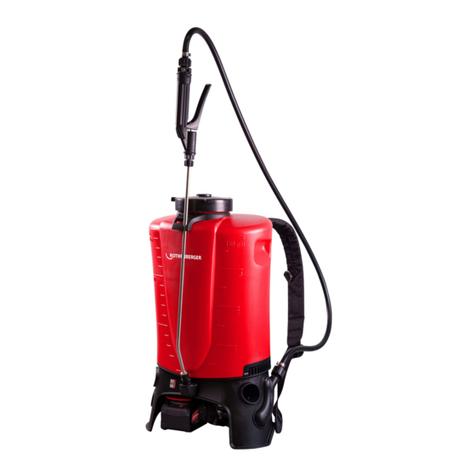
Rothenberger
Rothenberger ROSANI Clean 15 Instructions for use

Nilfisk-Advance
Nilfisk-Advance SW900 Operating guidelines

Nilfisk-Advance
Nilfisk-Advance Hybrid ECO SE11 Directions for use
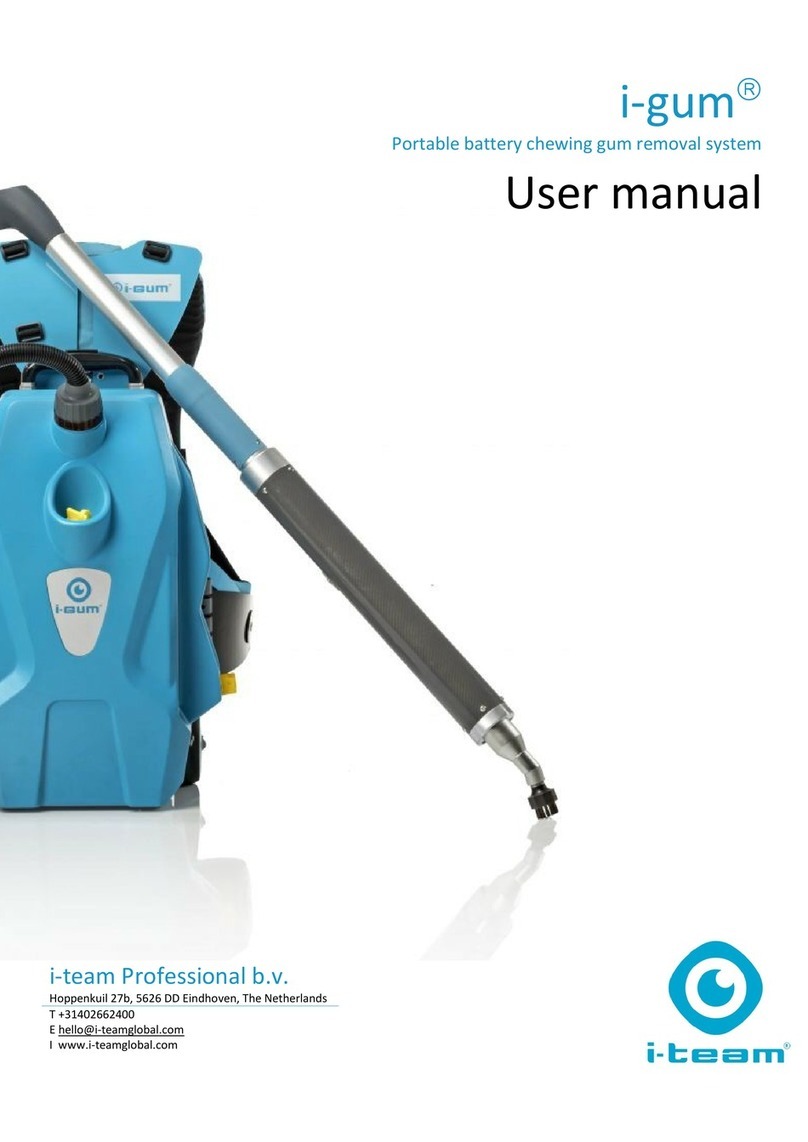
i-team
i-team i-gum user manual

US Steam
US Steam Blue Evolution user manual
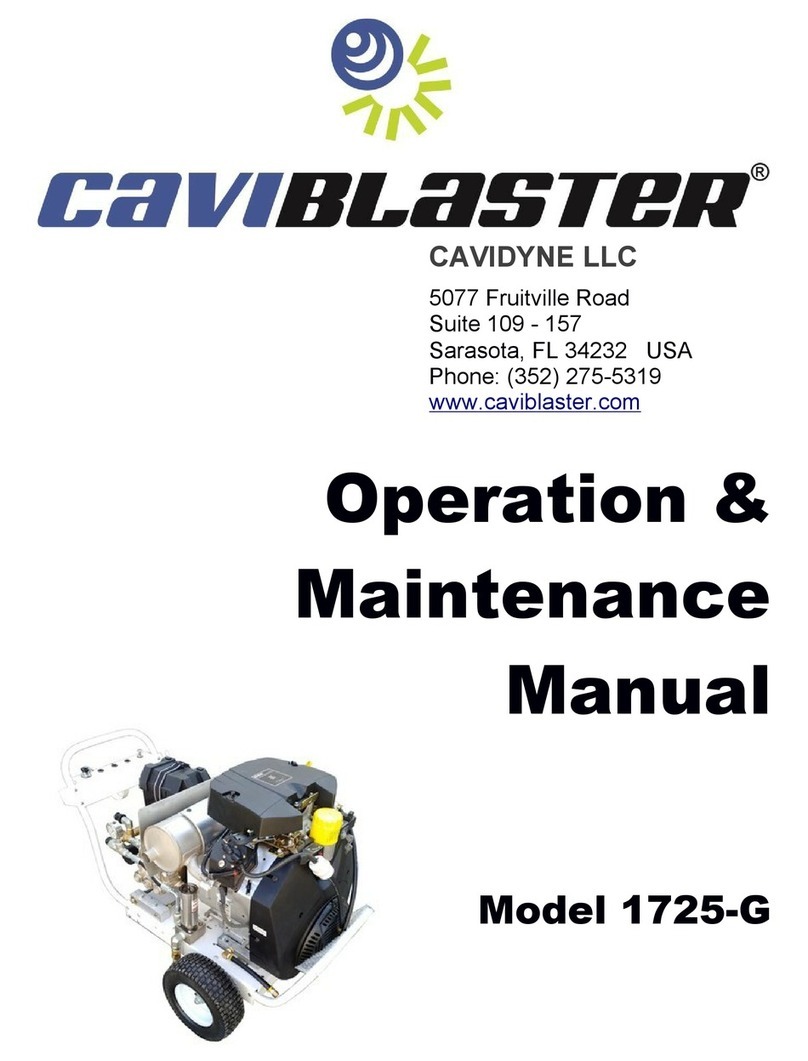
Caviblaster
Caviblaster 1725-G Operation & maintenance manual
